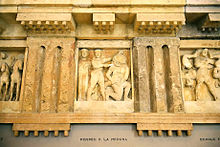Gutta


The gutta ( Latin drop , mostly plural guttae , German occasionally also called calf tooth ) is a drop-like hanging element on the underside of certain structural elements in the Greek temple building in the Doric style , which was either widened conically or cylindrically.
From the second half of the 6th century BC Chr., The guttae regularly in three rows of six drops on the undersides of the Mutulusplatten the Doric Geisons attached. Six guttae in a row also adorn the undersides of the regulae , small strips that were worked under the crowning taenia of the Doric architrave . In the early phase of Doric stone architecture, the number of their guttae could only be four, with the Mutuli there were solutions with alternating wide and narrow panels, with the latter then reducing the number of guttae to 3 × 3. There were also initially two-row versions with, for example, 2 × 5 guttae.
The guttae are interpreted by some research as an anachronistic replica of the nails in the original wooden structure of the Doric temple.
The motif of the triangular guttae is taken up again in Italian mannerism. Take the example of the Palazzo degli Elefanti , where triangular guttae can be seen instead of the capitals on the continuous pilasters.
swell
- Vitruvius : de architectura 4.1.2 and 4.3.6
Web links
- Geison with Guttae from the west porch of the Propylaea ( Acropolis )
Individual evidence
- ^ Christoph Höcker : Metzler Lexicon of Ancient Architecture. 2nd Edition. Metzler, Stuttgart 2008, ISBN 978-3-476-02294-3 , p. 114.
- ^ Anthony Blunt: Sicilian Baroque. 1968. (German: Sizilischer Barock . Frankfurt am Main 1972, ISBN 3-7606-0104-9 , p. 23)